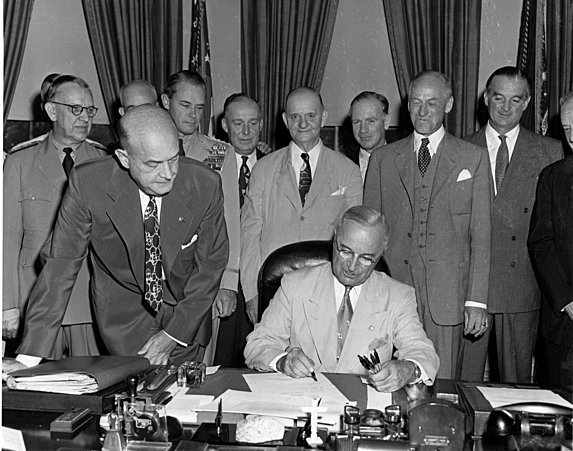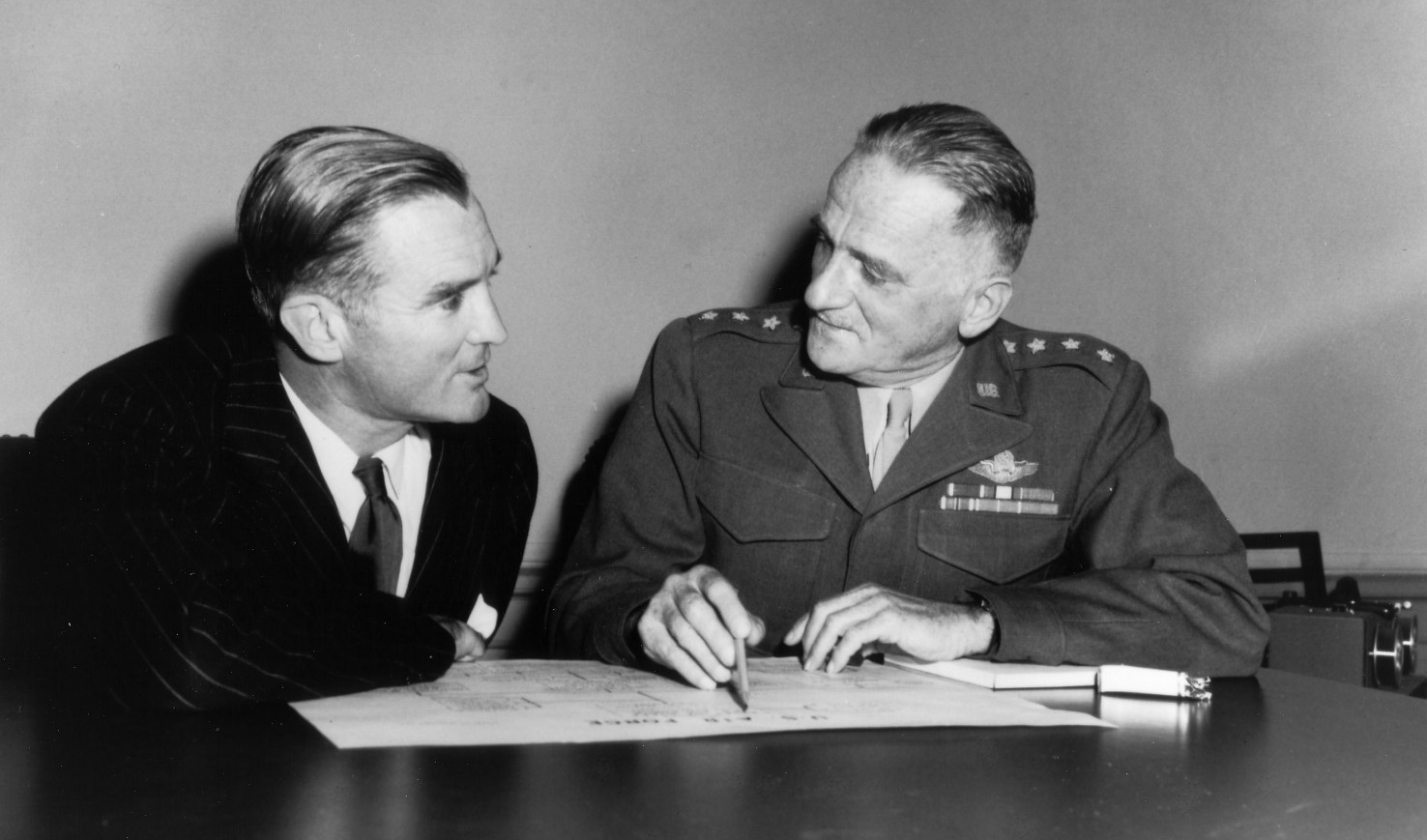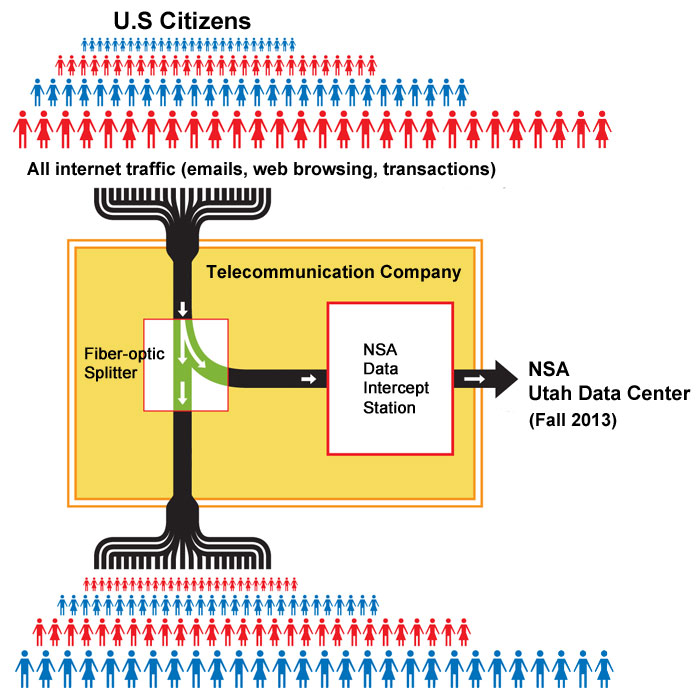
The National Security Act of 1947 represented a major reorganization of America’s military establishment, unifying the Army, Navy and a newly created Air Force under a new agency, the Department of Defense. A National Security Council would serve in the White House as advisers to the president and a Central Intelligence Agency constituted our first peacetime intelligence gathering body.
The Act was given its great impetus by the perceived threat of Soviet communism. Not since the Red Scare period immediately following World War I had Americans been so unnerved by the thought of a communist conspiracy infiltrating and undermining American democracy. The Soviet Union was in an aggressive, expansive mode promoting communist insurgencies in the Third World; in China, Mao and his followers were on the verge of toppling Chiang Kai-shek’s corrupt but western-friendly regime. One may argue that there was legitimate cause for concern about these developments and a need to counter Soviet aggression. But rather than facing this challenge with a levelheaded wariness, the American populace succumbed to full-blown paranoia — an anxiety more akin to political hysteria than a reasoned response to a national threat.
Harvard historian Murray Levin argued that this mood of fear and near-panic that possessed the popular imagination throughout the early Cold War years was not so much a spontaneous reaction as the result of an orchestrated campaign on the part of the power elite. In Levin’s words, "The proponent of political hysteria must maintain high levels of anxiety and justify extreme means to eliminate the threat. The threat, therefore, must be portrayed as enormously powerful and totally evil. This apocalyptic version of the conspiratorial theory of history is a functional necessity."
The purpose of all the fear mongering was to justify the expansion and reach of the National Security apparatus. While the hysteria lessened in intensity over the years, anti-Communist rhetoric remained a persuasive theme for Republican politicians, in particular. And the National Security State thrived, through administrations Republican and Democrat. Ronald Reagan was still talking about eight-foot-tall Russians and the imminent threat to our way of life, justifying ever-greater sums for a bloated Defense Department, while the Soviet Union fell into decay and collapsed of its own dead weight. By 1989 the great existential threat to America had passed. The western democracies had first defeated fascism, and had now vanquished the communist threat. It seemed the country was about to be released from more than half a century of underlying dread, of fear of internal subversion and nuclear annihilation.
But this lessening of tension did not last long, if we ever experienced it at all. With the attacks of 9/11 and George’s Bush’s declaration of a War on Terror, Americans were again beset by fear and paranoia and confronted with a new epochal war with no end in sight. The National Security apparatus that seemed to have lost much of its purpose with the fall of the Soviet Union got a new lease on life. If Americans were scared by the events of 9/11, it suited the Bush Administration to maximize that fear. As Levin put it, “The hysteria....escalates because it is necessary to continuously frighten the American people. Their support is based in large part on anxiety—anticipation of future conspiratorial danger."
The surveillance state has expanded massively over the last decade, its capacity for monitoring and storing information made vastly more invasive and powerful by new technology. Glenn Greenwald of the Guardian, an author and guest on Bill Moyers and Company, points out the irony of this latest assault on our privacy and our rights. “The surveillance state,” he told Moyers, “doesn’t really do much in terms of giving us lots of security. But what it does do, is it destroys the notion of privacy... The way things are supposed to work is we’re supposed to know everything that the government does with rare exception, that’s why it’s called the public sector. And they’re supposed to know almost nothing about us... This has been completely reversed, so that we know almost nothing about what the government does. It operates behind this impenetrable wall of secrecy, while they know everything about what we’re doing, with whom we’re speaking and communicating, what we’re reading.”
In the government’s desire to maintain secrecy, the Obama administration has invoked the Espionage Act of 1917 to silence whistleblowers and prevent leaks to the press. Five people were prosecuted in 2010, all for leaks to the press, and more recently cablegate whistleblower Private Bradley Manning. The Espionage Act of 1917, based on the Defense Secrets Act of 1911 — which was in turn based on the British Official Secrets Act — prohibited any interference with military operations or recruitment and, in a particularly vague provision, any perceived support of America’s enemies during wartime. The Espionage Act has been amended repeatedly and challenged in the courts but, with the open-ended War on Terror, remains a useful tool to silence dissent.
As ominous as these developments are, the techniques for keeping tabs on American citizens and suppressing dissent have a long and unsavory history that predates the National Security Act of 1947 by some fifty years. The actions of the administration of Woodrow Wilson in 1917 represent the most obvious and egregious antecedent. In order to stir up support for a very unpopular war, Wilson created the Creel Commission of Public Information, a propaganda machine that turned indifferent Americans into anti-German zealots practically overnight. The Creel Commission’s legal counterpart, the Espionage Act — and the even more draconian Sedition Act — granted the government sweeping powers to suppress and prosecute anyone voicing even the smallest criticism of the war effort. The Justice Department sponsored the American Protective League; by June 1917, units in 600 American towns and cities counted nearly 100,000 members.
The Creel Committee urged all Americans “to report the man who cries for peace, or belittles our efforts to win the war.” The ears of the American Protective League were everywhere—in schools, churches, at the workplace, in public meetings and private clubs, on the street. “It is the duty of every good citizen to communicate to proper authorities any evidence of sedition that come to notice.” An enthusiastic public did its part, reporting three million people, even children, for comments or activities deemed disloyal. 300,000 young men were classed as draft evaders, 175,000 of them “arrested and disciplined, often by jail sentence, invariably by a whipped-up scorn that could ruin business careers and family lives.” In 1918, Attorney General A. Mitchell Palmer wrote, “...never in its history has the country been so thoroughly policed.”
This was strong stuff but, in fact, the origins of the modern surveillance state can be traced back even further. In a provocative essay, “Policing America’s Empire: The United States, The Philippines, and the Rise of the Surveillance State” (Madison, U. of Wisconsin Press, 2009), historian Alfred W. McCoy makes the case that the methods of the American national security state were conceived as a response to an all but forgotten war in the Philippines. In 1898, with the American victory over Spain in the Spanish-American War, Spain ceded the Philippines to the United States for $20 million. The Filipinos were determined to gain their independence and war broke out in Manila on Feb. 4, 1899. Brave as the Filipinos were, they were no match for America’s new machine guns, long-range artillery and very aggressive young men with repeating rifles. Only after 9 months and many costly defeats did the Filipino leadership convert to guerrilla tactics. The guerrilla phase of the war was far more damaging to the Americans and created alarm both in Washington and among the military leadership in the islands.
In order to prevail, the Americans resorted to increasingly harsh tactics, the concentration of civilians into camps where they died by the thousands of disease and malnutrition, the slaughter of livestock, destruction of crops, burning of villages, and summary execution marked by an untold number of atrocities. Military historians consider these operations masterpieces of counterinsurgency warfare; others liken them to the criminal bludgeoning of a weaker people into submission. In July 1902, President Roosevelt announced the war ended. The dates 1899 to 1902 are invariably attached to any history of the conflict, but serious historians of the subject know that the date Roosevelt appended was an arbitrary one, one created for home consumption. Two competing narratives, a rosy one for public consumption, the real one for the administration’s private information, continued for years. The cheerful reports arrived regularly in Washington while the Filipinos kept fighting and resisting. A British woman living in the islands, Mrs. Campbell Dauncey, wrote in 1905: “The Americans give out... that the Philippine Islands are completely pacified, and that the Filipinos love Americans and their rule. This ... is complete and utter humbug, for the country is honeycombed with insurrections and plots; the fighting has never ceased, and the natives loathe the Americans and their theories.“
This was the first time America had ever fought a war to suppress another peoples’ aspirations for independence. The problem they faced was not just winning the war militarily but in persuading the people they had defeated to accept American colonial rule. The period from the supposed end of hostilities in 1902 until the end of the decade marked a third phase of the war. The young officers who served in the Philippines represent the shift from the old frontier army of the Nineteenth Century to a modern Twentieth Century military. These men developed the techniques employed to gain full control over the Filipinos and in doing so they far outdid their colonial predecessors in developing police surveillance tactics. In the words of Alfred W. McCoy: “Despite certain strengths, none of these could match the synthesis of legal repression, incessant patrolling, and suffocating surveillance found in the colonial Philippines.”
The army created five integrated security agencies, a centralized telephone network, fingerprinting, photographic identification, and an index of police files of 200,000 alphabetized file cards with the means to collect, retrieve and analyze a vast amount of intelligence. They employed spies in ceaseless surveillance and used their powers to censor public discourse, infiltrate civil society, penetrate households, and monitor private mail. They applied military intelligence and data management to problems of political espionage and developed covert techniques of surveillance and penetration in a decade-long effort to coerce the Filipinos into submission. McCoy sums up their achievement:
"In the first decade of civil rule the colonial government covered the archipelago with a coercive apparatus that was invisible in its covert penetrations, omnivorous in its appetite for information, and enveloping in its omniscience. Regular regiments stood ready near the capital to quell any disturbance, constabulary companies crisscrossed remote hinterlands, and municipal police guarded town plazas and city streets. Armed resistance was met with mass slaughter as artillery and repeating rifles covered the ground with corpses. Nationalist agitation was contained through a suffocating surveillance, labor agitation was crushed by arbitrary arrests and agent provocateur operations. Within a decade this total information regime had pacified the Philippines."
He concludes: “The sum of this colonial experience thus played a seminal role in building Washington’s domestic counterintelligence apparatus and, more broadly, its earliest covert capacity.”
The Filipinos had the misfortune of taking on a modern western power with no guidebooks or models to aid them in their struggle. Not only were they savagely reduced to submission but were then subjected to a decade of indoctrination, the first victims of the incipient American surveillance state. Now, a century later, Americans are the subjects of their own creation in its ever more sophisticated manifestations. The trend does not bode well for those who value their privacy and their independence.
Mike Morey is currently working on a history of the African-American Twenty-fourth Infantry's service in the Philippine-American War, 1899-1902.
3 WAYS TO SHOW YOUR SUPPORT
- Log in to post comments



















